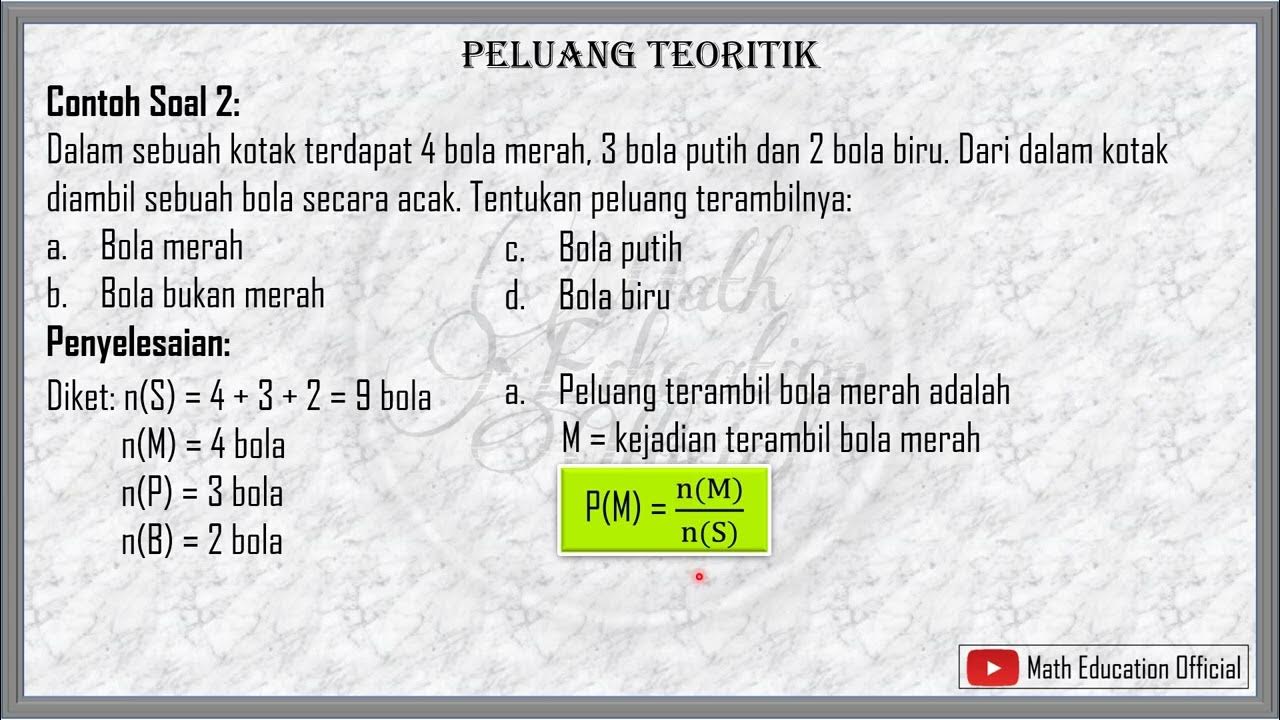4.1 An Introduction to Probabilities
Summary
TLDRProfessor Mitchell introduces Chapter 4 on probability, covering key concepts such as probability values, sample spaces, events, and methods of assigning probabilities. The classical method is explained through the example of rolling a die, while the empirical method involves conducting experiments and calculating observed probabilities. The subjective method is used when neither classical nor empirical data is available. The video also covers important probability properties, including the complement rule, and the law of large numbers, emphasizing how repeated experiments can align empirical probabilities with classical expectations.
Takeaways
- 😀 A probability is a numerical value between 0 and 1, indicating the likelihood of an event occurring.
- 😀 If an event is certain to occur, its probability is 1, and if it's impossible, its probability is 0.
- 😀 Vocabulary in probability includes terms like experiment (measuring/observing activity), sample space (all possible outcomes), and event (a subset of outcomes).
- 😀 A simple event contains only one specific outcome from the sample space (e.g., rolling a 5 on a die).
- 😀 The three main methods of assigning probabilities are: classical method (based on known outcomes), empirical method (based on repeated observations), and subjective method (based on intuition or experience).
- 😀 In the classical method, probability is calculated by dividing the number of favorable outcomes by the total number of possible outcomes in the sample space.
- 😀 Empirical probability involves conducting an experiment multiple times and calculating the frequency of an event occurring relative to the total number of observations.
- 😀 The law of large numbers states that the empirical probabilities will converge to the classical probabilities as more experiments are conducted.
- 😀 Subjective probability is used when classical or empirical probabilities are not available, often relying on intuition or historical data.
- 😀 Basic properties of probability include: probabilities range from 0 to 1, the sum of probabilities for all possible outcomes equals 1, and the complement rule states that the probability of an event plus its complement equals 1.
- 😀 The complement rule is useful when it's easier to calculate the probability of an event's complement and subtract it from 1 to find the event's probability.
Q & A
What is the range of probability values?
-Probability values range from 0 to 1, where 0 indicates an event will not occur, and 1 indicates an event is certain to occur.
What is the definition of an experiment in probability?
-An experiment in probability is the process of measuring or observing an activity in order to collect data, such as rolling a die or flipping a coin.
What is meant by the sample space of an experiment?
-The sample space is the set of all possible outcomes or results of an experiment. For example, the sample space for rolling a six-sided die is {1, 2, 3, 4, 5, 6}.
What is the difference between an event and a simple event?
-An event is one or more outcomes of an experiment, while a simple event contains only one outcome from the sample space and cannot be simplified further.
How do you calculate the probability of an event using the classical method?
-In the classical method, the probability of an event is calculated by dividing the number of favorable outcomes for that event by the total number of possible outcomes in the sample space.
Can you give an example of calculating probability using the classical method?
-For example, when rolling a die, the probability of rolling a five is 1/6, because there is one favorable outcome (rolling a five) out of six possible outcomes.
What is empirical probability, and how is it calculated?
-Empirical probability is calculated by conducting an experiment multiple times and dividing the frequency of an event occurring by the total number of trials or observations.
How does the law of large numbers relate to classical and empirical probabilities?
-The law of large numbers states that as an experiment is conducted a large number of times, the empirical probability will converge to the classical probability. In other words, observed probabilities become closer to theoretical probabilities as the number of trials increases.
What is subjective probability, and when is it used?
-Subjective probability is used when classical or empirical probabilities are unavailable, relying on intuition, experience, or estimation to calculate the likelihood of an event.
What is the complement rule in probability?
-The complement rule states that the probability of an event and its complement (the event not occurring) must add up to 1. Mathematically, P(A) + P(A') = 1, where A is the event and A' is the complement of the event.
Outlines

Esta sección está disponible solo para usuarios con suscripción. Por favor, mejora tu plan para acceder a esta parte.
Mejorar ahoraMindmap

Esta sección está disponible solo para usuarios con suscripción. Por favor, mejora tu plan para acceder a esta parte.
Mejorar ahoraKeywords

Esta sección está disponible solo para usuarios con suscripción. Por favor, mejora tu plan para acceder a esta parte.
Mejorar ahoraHighlights

Esta sección está disponible solo para usuarios con suscripción. Por favor, mejora tu plan para acceder a esta parte.
Mejorar ahoraTranscripts

Esta sección está disponible solo para usuarios con suscripción. Por favor, mejora tu plan para acceder a esta parte.
Mejorar ahoraVer Más Videos Relacionados
5.0 / 5 (0 votes)






